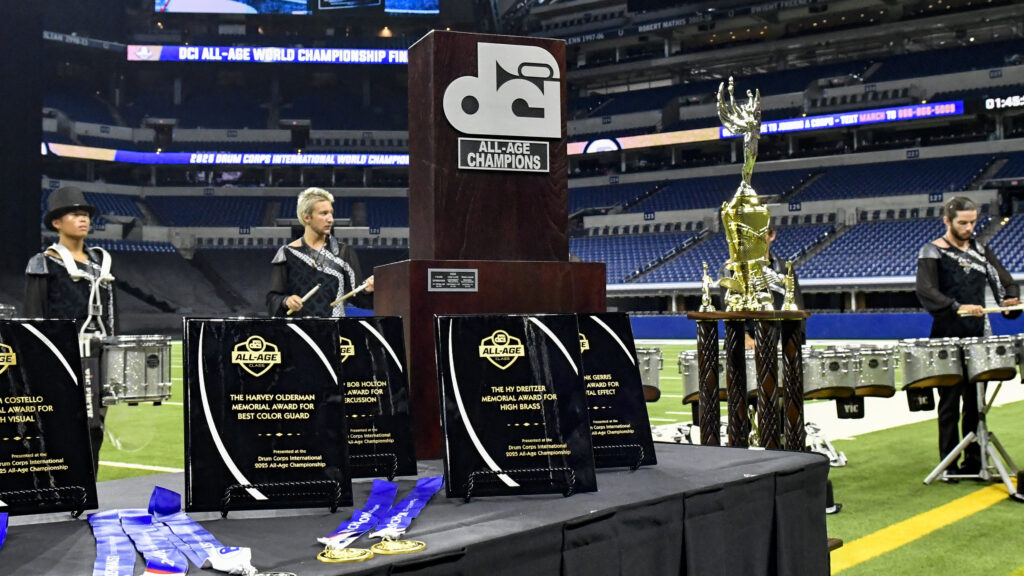Chuck Barris, creator and host of the 1970s television classic, “The Gong Show,” passed away last week at the age of 87. A pop culture icon of his day, Barris’ comedy-infused talent show influenced a number of interesting sidebars to drum corps history.
“The Gong Show” featured a wide-range of amateur competitors, running on NBC for two years from June 1976 through July 1978, and in syndication from its start through 1980. In many respects, it paved the way for the plethora of reality television shows debuted over the last decade from “American Idol” to “The X Factor.”
Frankly, most of the acts on the show, were of questionable talent, but occasionally, a really good performance would somehow sneak in. The worst of the acts faced the prospect of one or more judges walking (and sometimes running) to a large gong on stage and hit it with a large mallet, bringing the presentation to an oft-merciful close.
Gene Gene the Bridgemen Dancing Machine
A number of recurring comedic characters were regularly featured on “The Gong Show.”
Gene Patton, a stagehand at the NBC Studios in Burbank, California, created the character Gene Gene the Dancing Machine. Gene Gene started as one of the show’s warm-up acts, then became a recurring performer because Barris enjoyed his loveable and carefree abandon.
Gene Gene wasn’t particularly talented, and on a scale from 1 to 10, his vocabulary of dance moves had the creative range of 1 to 1.5. But he danced as if he didn’t care and fulfilled the adage, “Dance like no one’s watching.”
Murray Langston was another recurring character on the show, going by the moniker, The Unknown Comic. Langston earlier performed on a number of shows, including the network programs “Rowan & Martin’s Laugh-In” and “The Sonny & Cher Comedy Hour,” and for Barris’ show, performed wearing a paper bag over his head that had small holes cut for eyes and mouth. His “jokes” were intentionally bad and groan inducing, always delivered with a manic level of hyperactivity.
With a nod to these noteworthy pop culture icons, in 1979, both characters were recreated on the football field by members of Bayonne, New Jersey’s Bridgemen.
The two characters made their appearance during the corps’ performance of “Boogie Woogie Bugle Boy.”
When it appeared the tune had reached its end, the corps launched into a reprise tag, with Bridgemen’s own version of Gene Gene the Dancing Machine busting a move at the front of the field and then hoisting into his arms a female member of the corps who had been pretending to be an on-field judge.
At the end of the reprise, Gene Gene was joined by a dancing member of the horn line who wore a paper bag over his head as a salute to The Unknown Comic. The appearance was a favorite among drum corps fans all summer long, and to this day is remembered as one of the Bridgemen’s most iconic moments.
That Rifle Thing You Do
There was at least one more well-known drum corps connection to “The Gong Show.”
Robert Amaya played cymbals as a member of Santa Clara Vanguard in 1972 and contra bass in the corps’ horn line the following two years. In 1976, he became a member of Madison Scouts’ rifle line, making him a rarity as someone who has performed in the DCI World Championship Finals as a percussionist, horn player, and color guard member.
In 1976, Amaya returned to college in southern California after his tour with the Scouts. One of his fraternity brothers, who had a family member who worked for NBC Studios, encouraged him to audition for “The Gong Show” and to do “that rifle thing you do.” “That rifle thing” was the routine he performed at the 1974 California State Championships, where he won an award in the individual senior rifle division representing Santa Clara Vanguard. Needing music to accompany the act, he added a disco rendition of the “Firebird Suite” by the Sal Soul Orchestra
In the fall of 1976, Amaya was selected to tape his performance for the daytime version of the show. Amaya knew he would need a costume or uniform for the television performance and he developed several close friendships with members of the Anaheim Kingsmen during his years in the Vanguard. Since he had incorporated several signature moves used by the Kingsmen rifle line into his performance, and since he couldn’t think of a more visually appropriate uniform to wear for such an occasion, he took advantage of his connections and obtained one of the corps’ uniforms for his audition.
Amaya won that broadcast of “The Gong Show” with a perfect score of 30 points, and later in the season he was invited back to tape the nighttime version of the show, comprised entirely of previous daytime winners, winning that show as well.
In 1988, after NBC revived “The Gong Show” with a new host, the network contacted Amaya to ask if he would be interested in performing again. And once again, he received a perfect score of 30, tying for first place.
In remembering Chuck Barris, it’s challenging to not break into a smile when thinking about all the cringe-inducing acts that appeared on “The Gong Show.” Many of those acts make the ill-fated “What Would Ryan Lochte Do?” reality television series a few years back seem like a casting call for a reboot of theoretical physicist Stephen Hawking’s film version of “A Brief History of Time.”
Even better that we can crack that smile with a connection to our own fond drum corps memories.






